Morocco is a captivating country with a rich history, vibrant culture, and breathtaking landscapes. From the bustling streets of Marrakech to the serene Desierto del Sáhara, Morocco offers a diverse range of experiences for travelers.
Whether you’re looking for a relaxing getaway or an adventure-filled journey, Morocco tourism has something for everyone. With its unique blend of Arabic, Berber, and French influences, Morocco is a fascinating destination that will leave you with unforgettable memories.
Key Takeaways
- Explore the vibrant city of Marrakech
- Experience the serene Desierto del Sáhara
- Discover Morocco’s rich history and culture
- Enjoy the country’s diverse landscapes
- Immerse yourself in Morocco’s unique blend of influences
Discovering Morocco: A Land of Contrasts
Morocco is a land of vibrant contrasts, where the bustling cities and serene deserts await exploration. This North African country is a treasure trove of exciting experiences, from exploring ancient medinas to relaxing on coastal beaches.
When to Visit Morocco
The best time to visit Morocco is during the spring (March to May) or autumn (September to November), when the weather is mild and pleasant. These periods are ideal for exploring the country’s diverse landscapes, from the Atlas Mountains to the Desierto del Sáhara.
Getting Around Morocco
Getting around Morocco is relatively easy, with various transportation options available. You can travel by bus, taxi, or rental car, depending on your preference and budget. Major cities like Marrakech y Fez have well-connected public transportation systems, making it easy to navigate.
Cultural Etiquette for Travelers
Understanding local customs is essential to enhance your Morocco travel experience. Dress modestly, especially when visiting mosques or rural areas. It’s also important to respect the holy month of Ramadan, during which Muslims fast from dawn to sunset. By being mindful of these cultural norms, you can have a more enjoyable and respectful trip.
Marrakech: The Red City’s Timeless Appeal
Marrakech, the Ciudad Roja, is a vibrant destination that captivates travelers with its rich history and cultural heritage. This city is a treasure trove of experiences, from its bustling squares to its serene gardens.
Jemaa el-Fnaa Square and the Medina
The heart of Marrakech is Jemaa el-Fnaa Square, a UNESCO World Heritage Site that comes alive with snake charmers, street performers, and food stalls. The surrounding Medina, with its narrow alleys and bustling souks, offers a glimpse into the city’s rich past. Visitors can get lost in the labyrinthine streets, discovering hidden gems and experiencing the local culture firsthand.
Majorelle Garden and Yves Saint Laurent Museum
A tranquil oasis in the midst of the bustling city, the Majorelle Garden is a must-visit attraction. Once owned by the famous designer Yves Saint Laurent, this garden is a masterpiece of landscape design, featuring exotic plants and striking architecture. The adjacent Yves Saint Laurent Museum showcases the designer’s work and legacy, offering insights into his inspiration and creative process.
Bahia Palace and Koutoubia Mosque
Marrakech is also home to several architectural marvels, including the Bahia Palace and the Koutoubia Mosque. The Bahia Palace, with its intricate craftsmanship and beautiful tile work, is a testament to the city’s rich cultural heritage. The Koutoubia Mosque, the largest in Marrakech, is a striking example of Almohad architecture, its minaret visible from various parts of the city.
| Attraction | Description |
|---|---|
| Jemaa el-Fnaa Square | Bustling square with snake charmers and street performers |
| Jardín Majorelle | Tranquil garden with exotic plants and architecture |
| Palacio de Bahía | Historic palace with intricate craftsmanship |
Fez: Morocco’s Cultural Capital
As one of Morocco’s imperial cities, Fez is renowned for its well-preserved ancient Medina and significant cultural landmarks. This historic city is a treasure trove of experiences, offering visitors a glimpse into the country’s rich past.
Navigating the Ancient Medina
The ancient Medina of Fez is a labyrinth of narrow streets and alleys, filled with historical sites and vibrant markets. Visitors can easily spend days exploring the Medina, discovering hidden gems, and immersing themselves in the local culture.
Some of the key attractions within the Medina include:
- Historic mosques and madrasas
- Vibrant souks (markets) selling everything from spices to handicrafts
- Traditional riads (houses with interior gardens)
The Al-Qarawiyyin University and Library
The Al-Qarawiyyin University, founded in 859 AD, is considered one of the oldest universities in the world. It has played a significant role in the intellectual and cultural history of the Islamic world. The associated library houses a vast collection of ancient manuscripts, some dating back to the 10th century.
The significance of Al-Qarawiyyin University lies in its:
- Historical importance as a center of learning
- Architectural beauty, reflecting traditional Islamic design
The Tanneries of Fez
The Tanneries of Fez are famous for their traditional leather production methods, which have remained largely unchanged for centuries. Visitors can witness the tanning process and see the vibrant colors of the leather goods on display.
The Tanneries offer a unique insight into Fez’s artisanal heritage, showcasing the skill and craftsmanship involved in traditional leather production.
Chefchaouen: The Enchanting Blue City
In the heart of Morocco’s rugged landscape lies Chefchaouen, a charming town famous for its blue-washed architecture. This picturesque town is nestled in the Rif Mountains, offering a serene escape for travelers. With its narrow streets, vibrant markets, and relaxed atmosphere, Chefchaouen is an ideal destination for those seeking a mix of culture and tranquility.
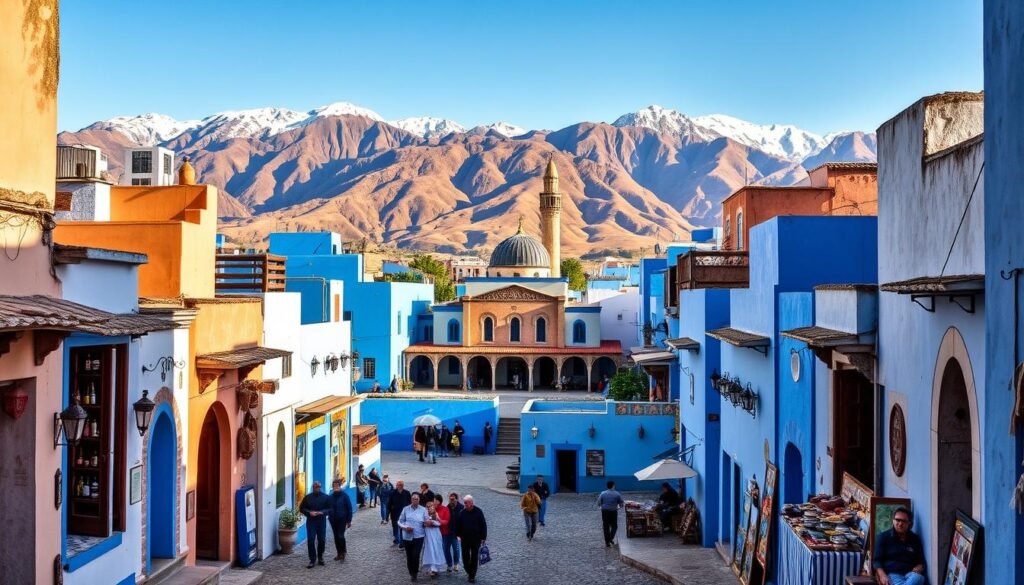
The History Behind the Blue Walls
The blue-painted buildings of Chefchaouen have become a hallmark of the town, but the reason behind this distinctive feature is less well-known. The tradition of painting buildings blue is believed to have been introduced by Jewish refugees in the early 20th century. According to “The Rough Guide to Morocco”, the blue color was thought to symbolize the sky and heaven, creating a sense of peace and tranquility. Today, the blue walls continue to attract visitors from around the world, making Chefchaouen a unique cultural and photographic destination.
Photography Spots in the Blue Pearl
Chefchaouen is often referred to as the “Blue Pearl” due to its breathtaking blue architecture. The town offers numerous photography spots, from the vibrant streets of the medina to the serene landscapes of the surrounding mountains. As one of Morocco’s most photogenic towns, Chefchaouen is a paradise for photographers. Visitors can capture stunning images of the blue buildings, explore the Kasbah, and enjoy the panoramic views from the Spanish Mosque.
Day Trips to the Rif Mountains
Beyond its blue walls, Chefchaouen serves as a gateway to the beautiful Rif Mountains. Visitors can embark on day trips to explore the region’s natural beauty, including hiking trails, waterfalls, and traditional villages. As
“A journey to the Rif Mountains is a journey into the heart of Morocco’s natural and cultural heritage.”
With its rich landscapes and welcoming communities, the Rif Mountains offer an unforgettable experience for travelers.
The Sahara Desert Experience
Embarking on a journey to Morocco’s Desierto del Sáhara is to enter a world of golden sands, nomadic traditions, and unforgettable landscapes. The vast expanse of the desert, with its towering dunes and serene silence, offers a unique adventure for travelers.
Merzouga and Erg Chebbi Dunes
En Erg Chebbi dunes near Merzouga are a highlight of any Morocco desert tour. Rising dramatically from the desert floor, these towering sand dunes create a breathtaking landscape that changes with the light of day. Visitors can hike to the top of the dunes, enjoying panoramic views of the desert’s vastness.
The experience of walking on the soft sand, feeling the desert’s tranquility, and witnessing the stunning sunrises and sunsets is truly unforgettable.
Camel Treks and Desert Camps
A quintessential part of the Desierto del Sáhara experience is a camel trek across the dunes, echoing the traditional travel methods of the local nomads. As the sun sets, travelers arrive at a desert camp, where they can enjoy traditional Berber hospitality, savor local cuisine, and relax under the starry desert sky.
These camps offer a range of activities, from stargazing to music and dance performances, allowing visitors to immerse themselves in the desert’s enchanting atmosphere.
Connecting with Nomadic Culture
One of the most enriching aspects of visiting the Desierto del Sáhara is the opportunity to connect with the local nomadic culture. Through interactions with the Berber people, travelers can learn about traditional ways of life, participate in tea ceremonies, and gain insights into the desert’s unique ecosystem.
This cultural exchange adds a profound depth to the desert experience, making a visit to Morocco’s Desierto del Sáhara a truly memorable adventure.
Coastal Escapes: Essaouira and Casablanca
Morocco’s coastline is home to two captivating cities: Essaouira and Casablanca, each offering a unique blend of culture and leisure. While they share the common thread of being coastal towns, they differ significantly in their charm and attractions.
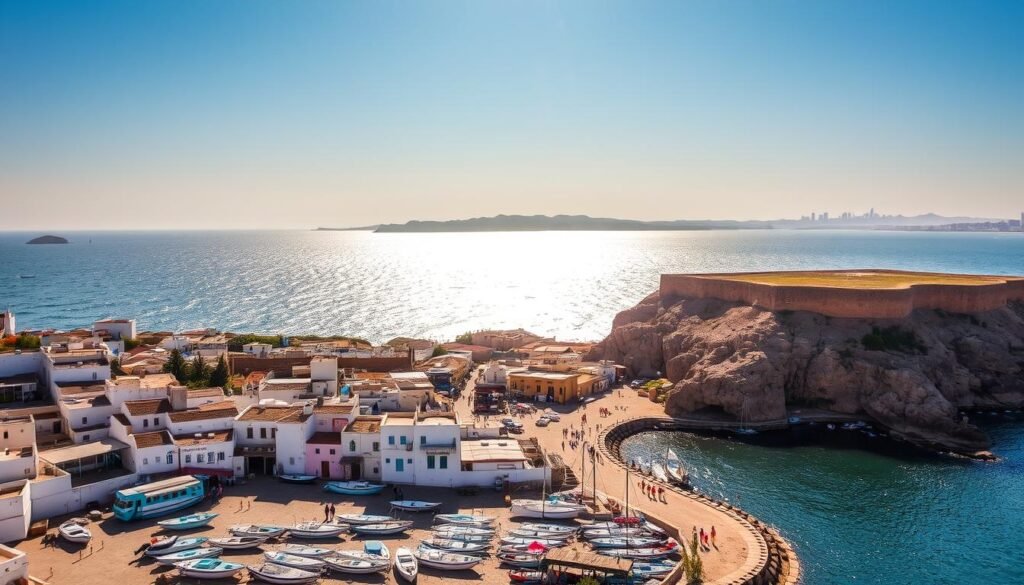
Essaouira’s Windswept Charm
Essaouira, with its windswept beaches and vibrant arts scene, is a haven for surfers and artists alike. The city’s ramparts and medina are steeped in history, offering a glimpse into Morocco’s rich cultural heritage. Visitors can enjoy:
- Relaxing on the beach or by the ramparts
- Exploring the local artisan community
- Savoring fresh seafood at one of the many local restaurants
Casablanca’s Hassan II Mosque and Modern Appeal
Casablanca, Morocco’s economic hub, boasts modern attractions that are a testament to the country’s contemporary vibe. The Mezquita de Hassan II, one of the world’s largest mosques, is a masterpiece of modern Islamic architecture. The city offers:
- A visit to the Hassan II Mosque for an architectural marvel
- Exploring the modern downtown area for shopping and dining
- Enjoying the city’s vibrant nightlife
Beach Activities and Seafood Delights
Both Essaouira and Casablanca offer a range of beach activities, from swimming and sunbathing to kitesurfing and windsurfing. The local seafood is a highlight, with fresh catches served in numerous restaurants along the coast. Visitors can indulge in:
- Water sports and activities
- Fresh seafood at local eateries
- Sunset views over the Atlantic Ocean
Atlas Mountains: Trekking and Berber Villages
Morocco’s Atlas Mountains are a treasure trove of natural beauty and Berber culture. This mountain range offers a diverse array of trekking opportunities, from leisurely day hikes to more challenging multi-day treks, catering to all levels of adventure seekers.
Toubkal National Park Hiking Routes
Toubkal National Park is a highlight of the Atlas Mountains, home to North Africa’s highest peak, Mount Toubkal. The park offers various hiking routes, ranging from relatively easy to very challenging. The most popular route is the ascent to Mount Toubkal’s summit, a rewarding experience for trekkers.
The trails in Toubkal National Park are well-marked, and guides are available for those who prefer not to navigate alone. The scenery is breathtaking, with traditional Berber villages and stunning mountain vistas.
Authentic Berber Experiences
One of the most enriching aspects of visiting the Atlas Mountains is the opportunity to experience authentic Berber culture. Visitors can stay in traditional Berber villages, where they can share meals with local families and learn about their customs and traditions.
This cultural immersion provides a unique insight into the Berber way of life, which is characterized by hospitality and a deep connection to the land. Guests can participate in local activities, such as traditional cooking and crafts.
Ourika Valley and Waterfalls
The Ourika Valley is another gem within the Atlas Mountains, known for its picturesque landscapes and natural beauty. The valley is home to several waterfalls, which are perfect for a refreshing swim or a relaxing picnic.
| Location | Actividad | Best Time to Visit |
|---|---|---|
| Toubkal National Park | Hiking, Trekking | Spring, Autumn |
| Berber Villages | Cultural Immersion | Year-round |
| Valle de Ourika | Sightseeing, Picnicking | Spring, Summer |
The Atlas Mountains offer a compelling mix of adventure, natural beauty, and cultural richness, making them an unforgettable destination for travelers to Morocco.
Best Places to Visit in Morocco for History Buffs
History comes alive in Morocco, where ancient ruins, imperial cities, and fortified kasbahs await exploration. Morocco’s rich historical heritage is a testament to its strategic position as a crossroads of cultures, empires, and civilizations.
Volubilis: Roman Ruins in North Africa
One of Morocco’s most significant historical sites is Volubilis, a UNESCO World Heritage Site that boasts some of the best-preserved Roman ruins in North Africa. Founded in the 3rd century BC, Volubilis was an important center of Roman culture and trade. Visitors can explore the remains of the city’s impressive basilica, triumphal arch, and mosaic floors, which provide a glimpse into the lives of its ancient inhabitants.
Meknes and Rabat: Imperial Cities
Morocco’s imperial cities, Meknes and Rabat, are steeped in history and architectural grandeur. Meknes, with its robust walls and monumental gates, was once the capital of Morocco under Sultan Moulay Ismail. Rabat, the current capital, is home to numerous historical landmarks, including the Hassan Tower y el Chellah Necropolis, a Roman-era archaeological site. Both cities offer a wealth of historical insights and cultural experiences.
Ait Ben Haddou: Morocco’s Famous Kasbah
Ait Ben Haddou, a fortified kasbah in southern Morocco, is another must-visit site for history enthusiasts. This UNESCO World Heritage Site has been used as a filming location for numerous movies and TV series, including Game of Thrones y Gladiator. The kasbah’s earthen architecture and strategic location make it a fascinating example of Berber and Arab influences in Moroccan history.
Conclusion: Planning Your Moroccan Adventure
With its diverse landscapes, rich culture, and vibrant cities, Morocco is a destination that promises an unforgettable experience. As you’ve explored the best places to visit, from the bustling streets of Marrakech to the serene beauty of Chefchaouen, it’s clear that Morocco travel planning is about crafting a journey that suits your interests.
Whether you’re drawn to history, culture, or relaxation, Morocco has something for everyone. By understanding the best times to visit, respecting local customs, and exploring the many attractions, you can create a Morocco vacation that is both memorable and enriching.
As you plan your trip, consider the various experiences Morocco offers, from trekking in the Atlas Mountains to relaxing on the coastal beaches. With careful planning, your Moroccan adventure will be a journey of discovery and delight.

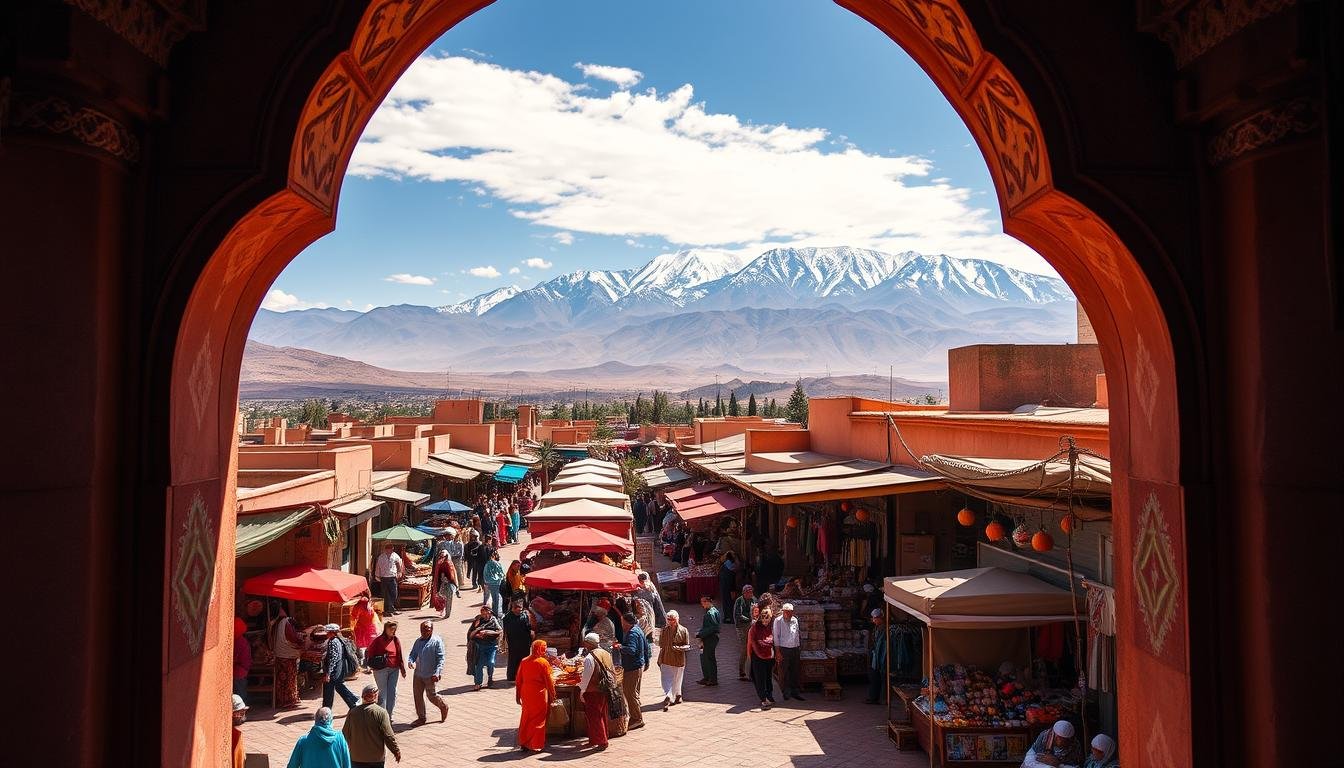
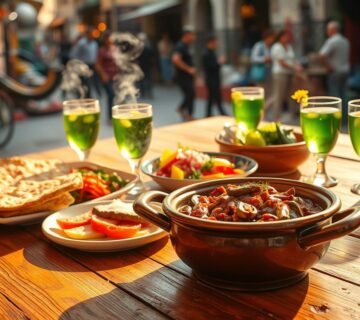
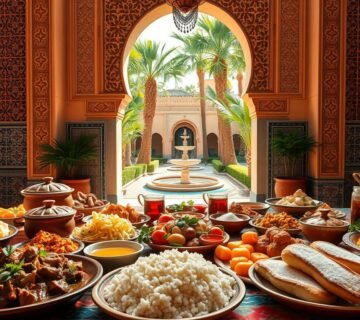
No comment